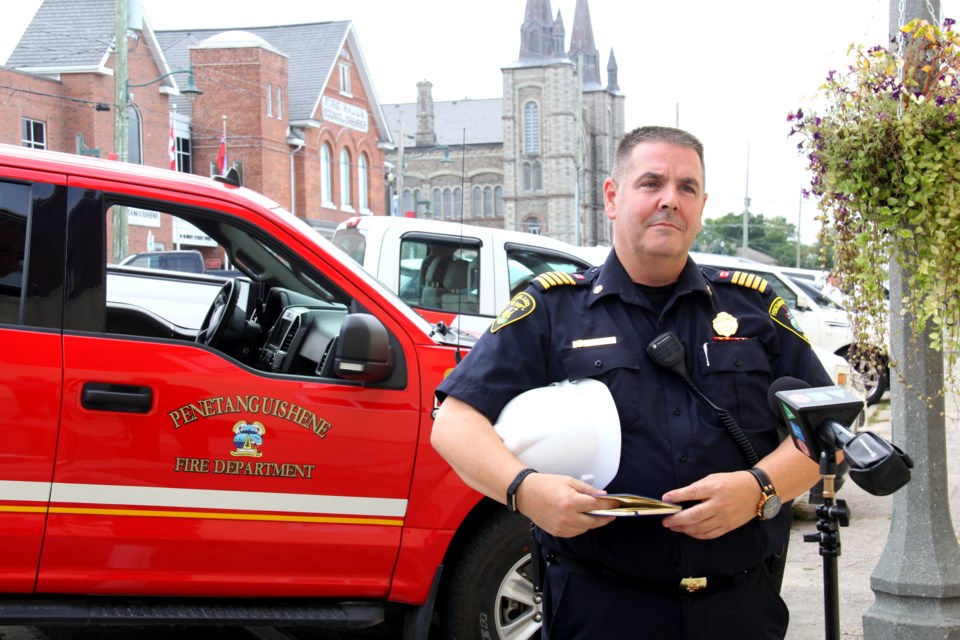North Simcoe municipalities are being treated to mandatory community risk assessment presentations, and the urban hub of Midland was privy to their top concerns and strategies of mitigation.
During the recent committee of the whole, Grace McDonough of the Loomex Group addressed the top public safety risks identified in the town from a fire services perspective as part of a five-year provincial regulation requiring all municipalities to conduct a community risk assessment before July.
“Community risk assessments are data-based,” explained McDonough as part of her introductory thanks to Midland and Penetanguishene joint Fire Chief Richard Renaud and his staff on aiding the data collection for the process. “It was weeks, if not months, of information flowing from them to us.”
Ranked through a matrix of risk levels ranging from the low end of rare with insignificant consequence, up to almost certain with catastrophic consequences, Midland faced three top ranking public safety risks and seven moderate risk items, as stated in the report.
The top three were severe weather event (risk level 120), fire/explosion in industrial occupancy (100), and critical infrastructure failure (96).
Pointing out a statistic regarding the fire/explosion in industrial occupancy, McDonough stated: “Midland has just under 60 industrial buildings and in the last five years there have been eight fires in industrial occupancies, and the dollar loss for those has been just over $1.6 million.”
Human health emergency (90) ranked fourth as the top moderate risk item, with McDonough acknowledging that it was very high everywhere when the assessments were undertaken over the past five years, with pandemic data as a factor.
Fire in residential occupancy was the fifth rank, with McDonough adding: “There have been 58 residential fires in Midland over the last five years with a dollar loss of just shy of $9 million; so it’s a considerable loss.”
Risk treatment plans were provided for each identified public risk, including mitigation measures of education and/or policies, financial implications, and a recommendation to implement the strategies into the fire department’s regular operations.
Of concern for Mayor Bill Gordon was the structural integrity of the downtown core, as his line of questioning noted Midland’s buildings as compared to the partial collapse of a similar-vintage building in Penetanguishene last year which resulted in displaced occupants but no fatalities or serious injuries.
“Since the event in Penetanguishene,” said McDonough, “I think a lot of municipalities who have older downtown cores are going to start to look at some of that structural engineering and start to put in place ways to ensure the safety of the public in and around those buildings and certainly the safety of the occupants of those buildings.”
Renaud added that current fire services did not have either mandate or staffing to support a proactive approach “where we could go in and investigate and try to limit the life safety hazards, (and) under our authority from the fire, to bring in the building department and other departments to address structural issues.”
When asked if there were any surprises in the report, Renaud confirmed there were none but his goal for "proactivity" was tempered due to the fire department dealing with complaint- and request-based inspections, which was time-consuming as they were dealt with by just one fire prevention officer.
Coun. Bill Meridis asked Renaud if the recent hiring of firefighters could take up that role, and was told firefighters' role involves suppression and a decrease in fire emergency response times.
“When it comes to inspections, you need to be certified and qualified to do that. Our firefighters, that’s not their area of expertise,” said Renaud. “They would not be able to support that part of it. Truly to do that, we’d need proper fire prevention inspectors and certified inspectors to do that; and currently we have one.”
Gordon concluded the discussion by expressing appreciation for the in-depth statistics and demographics included in the report, urging residents to read up on the 120-page document as a way to know the overall community better.
“There’s a lot of information about the fabric of Midland, and it happens to be in this report,” stated Gordon. “If you have any interest in understanding a bit more about the demographics of this community, it’s kind of a neat go-to spot. It’s a little side bonus, because it puts context around the risk.”
Education on fire safety in Midland can be located on the fire and emergency services page of the town website.
The Loomex Group community risk assessment report, including slideshow presentation, is available in the council agenda on the town of Midland website.
Council meetings are held every third Wednesday, and can be viewed on Rogers TV cable channel 53 when available, or through the livestream on the Rogers TV website. Archives of council meetings are available through Rogers TV and on the Town of Midland’s YouTube channel.



